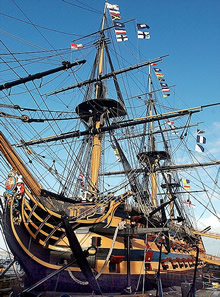
Critics' Opinion:
Readers' Opinion:
First Published:
Apr 2009, 464 pages
Paperback:
Jan 2010, 544 pages
 Book Reviewed by:
Book Reviewed by:
Kim Kovacs
Buy This Book
Publicists often use comparisons to well-known authors to convince readers to
pick up a novel by an unknown writer. In the case of The Red Wolf Conspiracy,
this tactic does the author a disservice. Robert Redick's writing is so good and
original that neither of the comparisons listed in the book's description do it
justice. If you're expecting another Game of Thrones or Golden Compass,
you'll be disappointed, as The Red Wolf Conspiracy resembles neither. If
you're looking for a simply great fantasy read, though, this is your book.
The Red Wolf Conspiracy falls neatly into the "high fantasy" genre.
Redick immerses the reader in themes and archetypical characters many will
recognize from other novels in the category (good vs. evil; the young
protagonist with a mysterious skill and/or past; the malevolent Dark Lord who
wants to take over the world; etc.) Redick, though, puts a unique spin on this
tried and true format, turning the reader's expectations upside down and
creating a story that engages the imagination. By and large, it's completely
unpredictable. It's also very complicated; there's so much going on that the
plot defies description.
What really sets this novel above the norm, though, is the quality of Redick's
writing. Like most fantasy novels, this book contains a huge number of
characters. Amazingly, nearly all of them are three-dimensional. Even characters
with "bit parts" are fully-developed. There may be an occasional stereotype here
and there, but they're rare. It's a remarkable feat considering the large cast.
He also does a marvelous job of portraying the swashbuckling nature of the
story. His descriptions of life on the sea and of the tall sailing ships seem
dead on, and his action sequences frequently leave the reader breathless.
The Red Wolf Conspiracy is geared toward a very broad audience. The book
has no sexual content and the violence depicted isn't extreme, making it
appropriate fare for young adults. More mature readers will appreciate its
intricate plot, richly imagined world and high-quality narrative.
 The one criticism that could be leveled against the novel has to do with its
overall pacing. The first hundred pages or so are devoted to acclimatizing
readers to the world Redick imagines for his characters. As such, it's very
well-written and detailed, but may bore readers more interested in an
action-adventure novel. The last hundred pages rush by in a blur. While very
exciting, these final pages are less convincing and not as well-written as prior
chapters. As a result, readers who've been enjoying the detailed writing may feel a bit of a
let-down at its end.
The one criticism that could be leveled against the novel has to do with its
overall pacing. The first hundred pages or so are devoted to acclimatizing
readers to the world Redick imagines for his characters. As such, it's very
well-written and detailed, but may bore readers more interested in an
action-adventure novel. The last hundred pages rush by in a blur. While very
exciting, these final pages are less convincing and not as well-written as prior
chapters. As a result, readers who've been enjoying the detailed writing may feel a bit of a
let-down at its end.
The Red Wolf Conspiracy is the first book in a planned series. While it
ends at a natural break point, most plot lines remain unresolved. In fact,
readers will discover they've only scratched the surface of Redick's complex
world; multiple layers await discovery in the remaining volumes in this epic
series. It's a very promising debut by a talented author, one which will
definitely leave fantasy fans eagerly anticipating the next installment.
Photo: Nelson's flagship Victory which, like The Chathrand, has seven decks plus a hold.
![]() This review was originally published in May 2009, and has been updated for the
January 2010 paperback release.
Click here to go to this issue.
This review was originally published in May 2009, and has been updated for the
January 2010 paperback release.
Click here to go to this issue.
The Red Wolf Conspiracy takes place almost entirely aboard an immense
sailing ship (aka "tall ship") with seven decks and five sails, similar, albeit perhaps on a grander scale, to those one might envision in use during the 18th
century. Although the book is set in a fantasy world, Redick references familiar
ship types and crew positions throughout the novel.
A tall ship* is a large traditionally rigged sailing vessel. Tall ships are defined by their rigging, their masts and, in particular, by their sails. Some of the more common ship types are:
In addition to the crew (aka the "hands"), other important positions aboard an 18th century ship would have included:
![]() This review was originally published in May 2009, and has been updated for the
January 2010 paperback release.
Click here to go to this issue.
This review was originally published in May 2009, and has been updated for the
January 2010 paperback release.
Click here to go to this issue.
Your guide toexceptional books
BookBrowse seeks out and recommends the best in contemporary fiction and nonfiction—books that not only engage and entertain but also deepen our understanding of ourselves and the world around us.